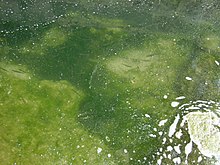Spanish toothcarp
| Spanish toothcarp | |
|---|---|

| |
| Male toothcarp (top) and female toothcarp (bottom) | |
| Scientific classification | |
| Domain: | Eukaryota |
| Kingdom: | Animalia |
| Phylum: | Chordata |
| Class: | Actinopterygii |
| Order: | Cyprinodontiformes |
| Family: | Aphaniidae |
| Genus: | Apricaphanius |
| Species: | A. iberus
|
| Binomial name | |
| Apricaphanius iberus (Valenciennes, 1846)
| |

| |
| Distribution of Aphanius Iberus in Spain | |
| Synonyms[2] | |
| |

The Spanish toothcarp (Apricaphanius iberus), also known as the Spanish pupfish or Iberian
A similar fish in the peninsula's south-west has been classified as an independent species, Apricaphanius baeticus. Apricaphanius saourensis is another similar species in Algeria.
Description
Morphology
This is a small fish, rarely more than 5 centimeters (2.0 in) in length. Females are longer than males of the same age. It has an oblong body and rounded fins. Its dorsal fin is underdeveloped with respect to the fish's girth. It has large scales, numbering 20 to 26 across the body at its widest point.
It has obvious
Reproduction
The lifespan of a Spanish toothcarp is short. They reach sexual maturity at age three months. The females spawn repeatedly each season, producing from 100 to 900 eggs.[6] Toothcarps in the Murcia region tend to spawn between April and August, while more northerly populations, such as those in the Delta del Ebro, lay their eggs between May and August. Spawning is usually done in areas with nearby vegetation, which shelters the eggs.
Hatchlings emerge approximately eight days after the eggs are laid. Females that hatch in April are able to reproduce in June.
While the females spawn, adult males set up small territories that they defend from other males in ritualized combats through which they court the females.
Behavior
The Spanish toothcarp is an omnivore, and eats
. Generally, toothcarps travel in small groups, staying near underwater vegetation, where they normally go unnoticed.The biology of the Spanish toothcarp is characterized by a high growth rate, early maturity, a high reproductive rate, multiple periods of egg-laying and a short lifespan. From an evolutionary ecology point of view, this lifestyle is highly adaptive for fish that live in unstable environments, such as estuaries, where unpredictable conditions increase mortality. This strategy allows the toothcarp to exploit environmentally favorable conditions during the short intervals in which they occur, thereby revitalizing the population.[7][8]
Habitat
Spanish toothcarp inhabit shallow, slow-moving bodies of water such as river-mouths,
Despite their adaptability, they have been displaced by invasive species, such as both species of mosquitofish,[9] introduced from North America to Spain in 1921 by doctor Sadí de Buen Lozano in an attempt to control malarial mosquitoes.[10] The toothcarp has retreated to high salinity areas where the mosquitofish cannot live.
Distribution
The Spanish toothcarp is characteristic of the Iberian peninsula, and extends from the Aigüamolls of
They have been found in the
Divergence between populations
Molecular analysis, together with
Conservation status
Despite being distributed over a large area on the peninsula, the Spanish toothcarp is largely found in small, threatened areas. Because of this, the Spanish Ministero de Medio Ambiente lists it as an endangered species.[14]
Among the threats are:[15]
- Water contamination by agricultural and urban waste
- Habitat destruction, primarily from development
- Louisiana crawfish, mosquitofish and largemouth bass
- Disappearance of channels and irrigation ponds
- Stream bed contamination by accidental spills
- Unintended consequences of combating eutrophication from algae, using toxic chemicals such as copper sulfate, or by covering them to prevent sunlight from reaching the water
- Eutrophication from algae
- Contamination of albuferas
- aquarists. This interest has recently shifted to more colorful tropical fish.
Vernacular names
This fish is known as fartet or peixet de sequiol in Spanish and Catalan (the latter sometimes uses the diminutive fartonet).
See also
- Samaruc- A similar Iberian killifish, from Valencia
References
- .
- ^ Bailly, Nicolas (2023). "Apricaphanius iberus (Valenciennes, 1846)". WoRMS. World Register of Marine Species.
- ^ Froese, Rainer; Pauly, Daniel (eds.) (2024). "Apricaphanius iberus" in FishBase. April 2024 version.
- ^ "'Aphanius iberus'". Integrated Taxonomic Information System.
- ^ "Enclave Ambiental- Fartet (Aphanius iberus). Familia Cyprinodontidae - Región de Murcia Digital". Regmurcia.com (in Spanish). Retrieved 28 March 2022.
- ^ "Fartet". Mediterranea.org. Retrieved 28 March 2022.
- ^ Vargas, M.J.; De Sostoa, A. 1997. Life-history pattern of the Iberian toothcarp Aphanius iberus (Pisces, Cyprinodontidae) from a Mediterranean estuary, the Ebro Delta (Spain). Netherlands Journal of Zoology 47, no. 2, pp. 143-160.
- ^ Gonzalez, E. G. (2018). "Phylogeography and Population Genetic Analyses in the Iberian Toothcarp (Aphanius iberus Valenciennes, 1846) at Different Time Scales". The Journal of Heredity. 109 (3): 253–263.
- .
- ^ De Buen, E. “Estudio experimental de algunas sustancias larvicidas antianofélica”. Tesis doctoral. Medicina de los Países Cálidos. 1929. Tomo II. en Fernández Astasio, B. (2002)
- ^ (Moreno-Amich, R., M. Planelles, C. Fernández-Delgado y García-Berthou, E. (1999). Distribución Geográfica de los ciprinodontiformes en la Península ibérica. Pp 33-57, en Planelles, M. (Ed.). 'Peces Ciprinodóntidos Ibéricos: Fartet y Samaruc. Monografía. Generalitat Valenciana (Valencia).)
- ^ Doadrio, I; Carmona, J.A. & Fernández Delgado, C. 2002. Morphometric study of the Iberian Aphanius (Actinopterygii, Cyprinodontiformes), with description of a new species. Folia Zool. 51(1): 67–79
- ^ [1] [dead link]
- ^ [2] [dead link]
External links
 Media related to Aphanius iberus at Wikimedia Commons
Media related to Aphanius iberus at Wikimedia Commons

